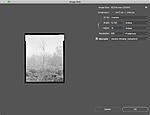Just looking for clarification that the method I am currently using for resizing after scanning with an Epson V800 scanner is considered to be the most optimal way.
Step 1
Scan at 2400ppi and bring into Photoshop.
Note: I have recently started to scan at 4800 wondering if this will give give me closer to the scanners optimal resolution of 2400.
Step2
Uncheck the resample checkbox and change the Resolution to match the printer (360 for the Epson R3880)
Step 3
Recheck the Resample checkbox, enter the desired output size and choose Bicubic Sharper (reduction) for the resample method.




 Reply With Quote
Reply With Quote


Bookmarks